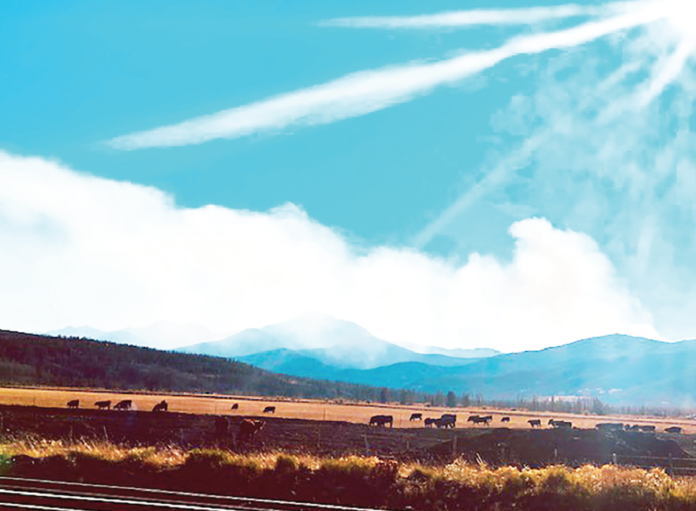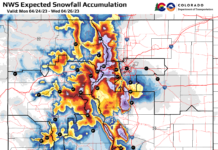
Williams Fork Fire
This past week, the Williams Fork Fire forest closure order was expanded due to extreme fire behavior. High winds grounded fire-fighting aircraft and pushed the fire below St. Louis Peak and St. Louis Peak towards McQueary Creek. Residents of the Keyser Creek, Crooked Creek, and St. Louis Creek areas near Fraser were directed to prepare to leave.
Since it’s human-caused start on August 14 near the Henderson Mill facilities on Ute Pass Road, the fire has grown to 12,993 acres and remains only 14% contained.
Two Type 1 helicopters worked the north flank of the fire to keep growth in check between the fire perimeter and Keyser Creek on Tuesday. The weather outlook for the foreseeable future calls for continued extreme drought conditions with weather conducive to active fire behavior, including low relative humidity, temperatures 10-20 degrees warmer-than-normal, and 20 mph winds out of the west/northwest.
Due to steep rugged terrain and dead and dying trees caused by Bark Beetle, indirect fire line tactics are being utilized. Natural barriers such as avalanche chutes, rock screes, high elevation alpine tundra ridges, previous fuel treatment areas, recent burn scars, and wet drainages have been identified to slow the fires’ spread. Bottle Pass, Saint Louis Pass, Fraser Experimental Forest (FEF) Headquarters and the Denver Water buildings located in the Bobtail drainage have been identified as areas of point zone protection. Fuels mitigation and placement of water handling equipment have been completed around the structures in both the FEF Headquarters.
More resources arrived at the fire on Wednesday, including crews, engines, and aircraft. A Type 2 team has been ordered. The multi-mission aircraft has flown the fire and updated acreage is expected. Due to the weather outlook and fire behavior, the forest closure order is expected to remain in place, as is, through
at least the middle of next week.
Middle Fork Fire
The Middle Fork Fire, north of Steamboat Springs, has grown to 8,037 acres since a lightning strike on September 6 and remains 0% contained.
The fire continues to creep and smolder along the fire perimeter, burning small pockets of available fuels. With forecasted sunny and warm, drier weather in the coming days, increasing fire activity can be expected, especially when winds align with fuels and terrain throughout the day.
Cold trailing, or ensuring the perimeter won’t reignite via touching/digging out every live fire spot to determine containment of the fire line in the Wilderness, is dangerous, says the most recent update. Thus the fire is likely to smolder until extinguished by snow accumulation.
A portion of the eastern fire perimeter has not advanced for over two weeks. Full suppression tactics are being employed, including the use of helicopters to keep fire growth in check and identifying indirect control features that offer a higher probability of success should fire advance toward homes or other structures. Closure areas will be reduced, minimizing impacts to public land users when it is determined safe to do so.
Regional fire bans remain in place, though some lessen restrictions
The White River and Little Snake field offices, along with Moffat and Rio Blanco counties, will revert from Stage 2 to Stage 1 fire restrictions on Wednesday, September 30. The Kremmling Field Office will also revert to Stage 1 restrictions within Summit County on October 2. The Colorado River Valley Field Office and Kremmling Field Office in Eagle County will remain in Stage 1 restrictions, while Kremmling Field Office in Grand, Jackson, and Routt counties will remain in Stage 2 fire restrictions.
“Large fires in Colorado and across the West are still impacting availability of firefighting resources,” said White River Field Manager Kent Walter. “Some of the hazardous fire conditions in northwestern Colorado have abated, however fuels remain extremely dry and receptive to fire, so people need to be very cautious using fire where it is allowed.”
Stage 2 fire restrictions prohibit any open flame. Stage 1 restrictions permit campfires only in approved fire grates at developed recreation sites. Smoking is restricted to interior locations and designated recreation sites. Chainsaws may only be operated with an approved spark arrestor. Welders and other torches with open flame may only be operated in cleared areas of at least 10 feet in diameter.
For more information on current fire activity, go to inciweb.nwcg.gov. For current fire restriction information, visit http://www.coemergency.com/p/fire-bans-dnger.html.








